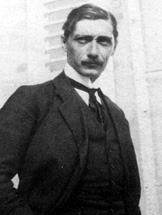The Gurdjieff Legacy Foundation Archives
Alexander (Alexandre) Gustav de Salzmann (1874–1934)

Alexander de Salzmann was born in Tiflis (Tblisi), Georgia, on January 25, 1874. His initial studies took him to Moscow and, after studying there, de Salzmann left for Munich where he was part of the artistic circle in the German Art Nouveau movement known as Jungendstil; his friends included Wassily Kandinsky and Ranier Maria Rilke. He contributed illustrations to the journals Jugend and Simplicissimus. René Daumal, his pupil, spoke of him as a "former dervish, former Benedictine, former professor of jui-jisu, healer, stage-designer...."1 He was also "a remarkable painter and a recognized metteur en scène, inventor of a new lighting technique...."2 On March 3, 1934, in Leysin, Switzerland, Alexander de Salzmann died from tuberculosis.3
In 1911 he met and married Jeanne Allemand in Hellerau, Germany, where she was studying dance at the Eurhythmics Institute of Emile-Jaques Dalcroze. At the time Hellerau was in the vanguard of artistic and educational development in Europe. In 1913, de Salzmann produced the German debut of Paul Claudel's play The Annunciation at Hellerau.
Because of the Russian Revolution, de Salzmann and his wife moved to Tiflis from Germany. Soon after, Gurdjieff and his pupils arrived in January of 1919. Thomas de Hartman met de Salzmann, whom he had known from their days in Munich. He learned de Salzmann was producing the scenery and lighting for the opera house productions of Carmen and Rigoletto in Tiflis. De Hartmann introduced de Salzmann and his wife to Gurdjieff and they became students. Gurdjieff said of the couple, "He is a very fine man, and she—is intelligent."4
That fall, the de Salzmanns, along with the de Hartmanns and Dr. Stjoernval, helped Gurdjieff establish his Institute in Tiflis and rehearsals began for Gurdjieff's ballet scenario The Struggle of the Magicians. In July 1920 Gurdjieff's group, with the de Salzmanns, moved to Constantinople. In August 1921 Gurdjieff and his students went to Germany. Finally, in October 1922, they went to Avon, France, where Gurdjieff established his Institute for the Harmonious Development of Man at the Prieuré.
At the Institute, Gurdjieff said he "could number on one hand his lieutenants with a real practical streak...."5 De Salzmann was one of this small group. One of his more notable tasks at the Prieuré was the decoration of the stable loft used by the writer Katherine Mansfield, who was dying from tuberculosis; the space had been vacated by Gurdjieff and given to Mansfield when she arrived.6 After Gurdjieff's near fatal automobile accident in July 1924, de Salzmann painted murals in the Montmartre district of Paris in an attempt to support the Institute financially.7 In 1928 Gurdjieff sent de Salzmann and his wife to Germany several times in the hopes of establishing a core group there.8 About de Salzmann and his wife, "Jeanne's flair for dance... Gurdjieff had wonderfully developed and elevated: but the artist's formidable gift had somehow been marginalized."9
By the summer of 1930, "Alexandre de Salzmann had more or less disappeared from the Institute."10 Upon his leaving he said, "I had entered the monastery under the name of Brother Petrus. I came out with the title of Father Sogol."11 After leaving the Prieuré, de Salzmann said, "I can't bring myself to fall in with this monkey-cage agitation which people so dramatically call life."12
Later, de Salzmann, who at the time was making a living as an antique dealer and interior decorator, met the avant-garde writer René Daumal and introduced him to Gurdjieff's teaching of The Fourth Way. The character of Pierre Sogol in Daumal's Mount Analogue is modeled on de Salzmann.
In 1933, quite ill at the time, de Salzmann met Gurdjieff at the Café Henri IV in Fontainebleau; what was said is not known. Gurdjieff's conviction was that de Salzmann, "in the sense of objective art, was 'the greatest of living painters.'"13 After Alexander de Salzmann's death, Jeanne de Salzmann led her husband's groups until 1939 when she introduced the students to Gurdjieff.
Notes
1. James Moore, Gurdjieff: The Anatomy of a Myth (Shaftesbury, Dorset: Element Books, 1991), 127.
2. Basarab Nicolescu, "The Strait Gate," The Gurdjieff International Review.
3. Ruth Sachs, White Rose History, ed. D. E. Heap and Joyce Light (Lehi, UT: Exclamation! Publishers, 2002), 59.
4. William Patrick Patterson, Struggle of the Magicians (Fairfax, CA: Arete Communications, 1996), 59. In Mme de Hartmann's unpublished memoir "What For?" she says the word used to describe Mme de Salzmann was "clever."
5. Moore, 182.
6. Ibid., 187.
7. Ibid., 208.
8. Ibid., 227.
9. Ibid., 228.
10. Ibid., 236.
11. Ibid., 236.
12. Ibid., 237.
13. Ibid., 249.